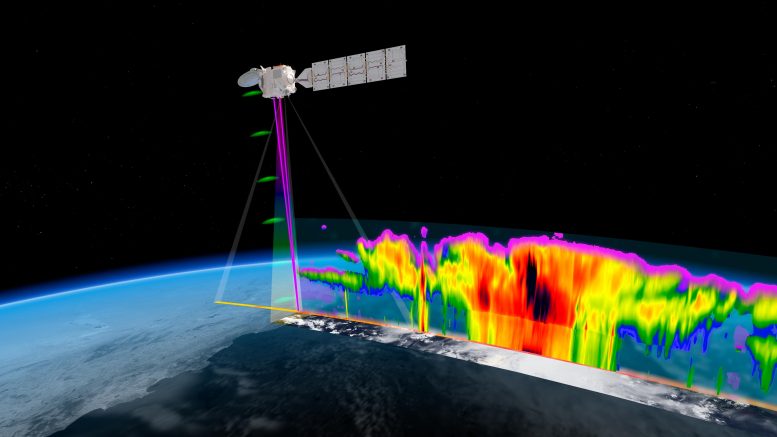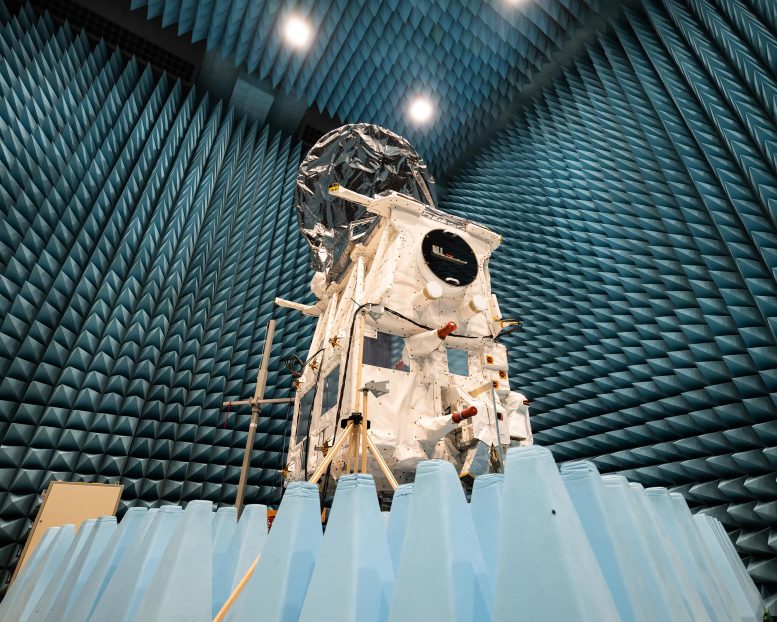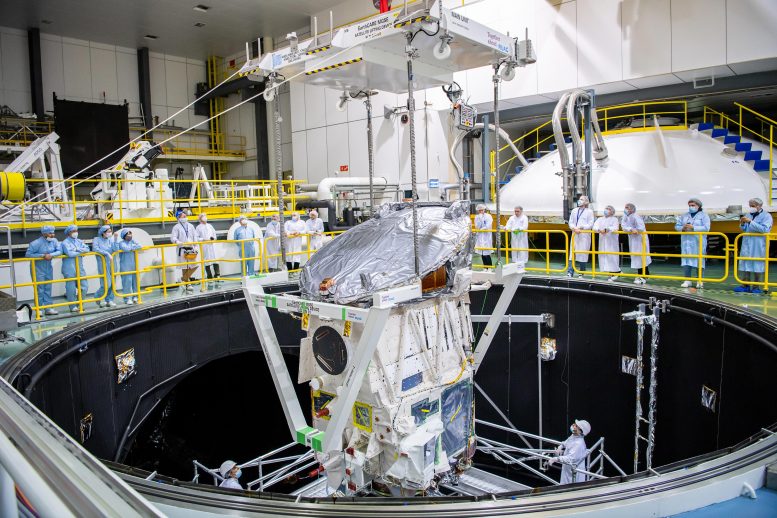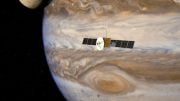
ESA’s EarthCARE mission carries a suite of instruments to answer some critical scientific questions related to the role that clouds and aerosols play in reflecting incident solar radiation back out to space and trapping infrared radiation emitted from Earth’s surface. Although clouds play an extremely important role in atmospheric heating and cooling, they remain one of the biggest mysteries – in fact the least understood factor – in our understanding of how the atmosphere drives the climate system. Credit: ESA/ATG medialab
ESA and JAXA’s EarthCARE satellite, set for a May 2024 launch, aims to provide insights into the climate effects of clouds and aerosols. The satellite has undergone comprehensive testing in Europe and will be launched via a SpaceX Falcon 9 rocket.
ESA and the Japanese Aerospace Exploration Agency are gearing up for a momentous milestone in Earth observation as launch of the EarthCARE satellite approaches.
Following years of rigorous development and extensive testing, the satellite is now undergoing its final round of tests in Europe before being shipped to the launch site early next year – bringing us one step closer to gaining unprecedented insights into the role that clouds and aerosols play in the climate system.
EarthCARE’s Significance in Climate Research
With global climate change increasingly affecting our planet, EarthCARE’s advanced instruments and technology are poised to provide invaluable data for climate research, improve the accuracy of climate models, and support numerical weather prediction.
Specifically, EarthCARE, which is short for the Earth Cloud Aerosol and Radiation Explorer, will answer some critical scientific questions related to the role that clouds and aerosols play in both reflecting incident solar radiation back out to space and trapping infrared radiation emitted from Earth’s surface. This delicate balance is an important factor in regulating Earth’s climate.
Although it is known that clouds play an extremely important role in atmospheric heating and cooling, they remain one of the biggest uncertainties in our understanding of how the atmosphere drives the climate system.

ESA’s EarthCARE satellite in the anechoic chamber for the electromagnetic compatibility tests in ESA’s ESTEC Test Centre in the Netherlands. The satellite spent almost 12 months in the Netherlands being tested to ensure that it will withstand the space environment once it is in orbit. Credit: ESA–SJM Photography
EarthCARE’s unique set of four instruments will provide a holistic view of the interplay between clouds, aerosols, and radiation.
Its cloud profiling radar will provide information on the vertical structure and internal dynamics of clouds, its atmospheric lidar will provide cloud-top information and profiles of thin clouds and aerosols, its multispectral imager will provide a wide-scene overview in multiple wavelengths, and its broad-band radiometer will measure reflected solar radiation and outgoing infrared radiation.
The fact that these different measurements are all taken at the same time allows scientists to better understand Earth’s radiation balance.
Complex Testing and Development
EarthCARE is the largest of ESA’s Earth Explorer satellites to date and, carrying such a comprehensive instrument package, development and testing has, unsurprisingly, been complex over the years.
More recently the satellite spent around 12 months at ESA’s ESTEC Test Centre in the Netherlands – the largest satellite test facility in Europe.

ESA’s EarthCARE satellite being lowered in the Large Space Simulator in ESA’s ESTEC Test Centre in the Netherlands. The satellite spent almost 12 months in the Netherlands being tested to ensure that it will withstand the space environment once it is in orbit. Credit: ESA–SJM Photography
This 3000 sq m, environmentally-controlled facility hosts test equipment to simulate every aspect of the space environment, from the vacuum and temperature extremes of Earth orbit to the violent noise and vibration of a rocket launch.
With these tests completed in the Netherlands, the satellite has now been shipped to Airbus in Germany for the last round of checks, which included testing for the transmitted shock when separating from the rocket’s adapter ring.
ESA’s EarthCARE Project Manager, Dirk Bernaerts, said, “We are extremely happy to see EarthCARE in great shape, with the tests demonstrating that the satellite will withstand the rigors of liftoff and the harsh environment of space.
We will soon be gearing up for the launch and then very much look forward to seeing our satellite deliver the data that is so needed by the scientific community.
“In fact, next month we are holding a science and validation workshop to help familiarize the science community with EarthCARE products, tools databases, and more.”
Upcoming Launch
The satellite is scheduled to be packed up and shipped to the Vandenberg launch site in California in early March, where it will be prepared for liftoff on a SpaceX Falcon 9 rocket in May.
EarthCARE is a joint venture between ESA and JAXA, the Japan Aerospace Exploration Agency.









“Although it is known that clouds play an extremely important role in atmospheric heating and cooling, they remain one of the biggest uncertainties in our understanding of how the atmosphere drives the climate system.”
Something that isn’t mentioned often, certainly not in this article, is that there aren’t any super-computers fast enough to calculate cloud-energy exchanges at the same spatial resolution as all the other physical processes in Global Circulation Models (GCM). To deal with that limitation, clouds are handled in GCMs with what is called parameterization. That is, experts make their best guess at what is happening, on average, and use a simplified model of cloud behavior. Even if “this extremely important role” is better understood, modelers are still constrained by computational limitations. While knowing more is a good thing, one shouldn’t have unrealistic expectations about how well we can predict the future. You might want to ask yourself why confidence intervals, or margins of error — always reported in political polls — are rarely mentioned in articles dealing with climatology.